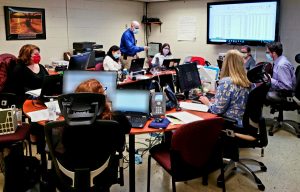
The ability to contact trace COVID-19 cases will be a key focus of Gov. Tom Wolf’s statewide plan to reopen, state officials have said.
Contact tracing is a keystone in disease control used by local, state, and federal health departments. The idea behind contact tracing is to quickly speak with infected patients and have them recall and identify where they had been and who they had close contact with during the period when they were infectious. Patients are told about the virus, encouraged to self-isolate, and officials may inform others who may have come in contact and are at risk of getting sick.
Contact tracing and widespread COVID-19 testing have been shown to be successful in places like South Korea, according to Forbes.
While other health departments and even the state have fallen behind on contact tracing, Bucks County has been able to contact about 95 percent of all positive COVID-19 patients. The ones who were not contacted did not call back or officials did not have correct phone numbers.
“As soon as you stop calling positives, you don’t learn who they are and what they do for a living,” Bucks County Health Department Director Dr. David Damsker said, adding the information is important to investigating and tracking illness.
Damsker stated that trends and common symptoms are key data that can be learned through the contact tracing process.
Before it was common knowledge, Damsker said contact tracing surfaced local patients who were suffering side effects related to changes and loss of their sense of taste and smell.
“We noticed weeks and weeks ago, a month ago – the issue of the loss of taste and smell. It wasn’t on the news or coming out of China and Italy, but we noticed it here in Bucks County very early,” Damsker said.
Bucks County Commissioner Bob Harvie pointed to the early discovery of impacts to senses of taste and smell as a sign contact tracers are doing a good job.
“We’ve had people that we call them and they didn’t think they had [coronavirus.] Some people say ‘no, I just had a stuffy nose for the past several days,’ but they got tested for whatever reason. They may have continued to go to work or continued to do things. We let them know right away – to get out of work or let people know right now. That’s why it’s so important to reach out to every single positive case. Every person you call could be spreading it to someone else,” the county health director said.
Damsker said the contact tracers call patients, get to know who they live with, and try to determine contact they had in the days they could have been shedding the virus.
With social distancing and the stay-at-home order, contact tracers have seen their jobs get a bit easier if not for the large number of positive cases that come in daily. Due to most people staying home, there are often less points of contact infected people make than with the early patients, Damsker said.
During the process, the county may speak with to potential places and people who may be at risk due to interactions with the ill people, whose identities are protected.
One challenge has been completing tracing going back weeks when the county learns of a positive test weeks after the patient first became sick, Damsker said.
Going forward, Damsker said “the biggest problem” is going to be keeping up with new cases of community spread that are sure to pop up as businesses reopen.
The county is working to get additional contact tracers to help if cases rise.
University of Washington School of Public Health Dean Hilary Godwin said states reopening need to be certain there won’t be a surge of COVID-19 cases once things start to get back to normal.
“What we want is to be confident that we have the capacity to identify coronavirus cases quickly and control the spread through contact tracing and isolation when we see them start to emerge again,” she said.
Contact tracing in a pandemic requires numerous people and time to contact each and every patient.
In Pennsylvania, only Allegheny, Bucks, Chester, Erie, Montgomery, and Philadelphia operate their own health departments with contact tracing abilities. The cites of Allentown, Bethlehem, Wilkes-Barre, and York also have a similar ability. For the rest of the state, a small group of statewide public health nurses perform contact tracing.
The Center for Health Security said in a recent report that the nation could use an extra 100,000 contact tracers as COVID-19 mitigation efforts end and to avoid another major outbreak.
Bucks County’s health department has about 40 staff members and volunteer reserve medical corps members who are working seven days a week on the COVID-19 response, Damsker said.
At least a dozen people are working to contact those with COVID-19 throughout the week.
Three nurses are in contact with health care facilities to learn more about those with COVID-19.
Apple and Google are currently working on voluntary apps for smartphones that will help with contact tracing, according to Bloomberg News. However, those apps aren’t expected to be required and their eventual reach is unknown.
Testing is also expected to be a large portion of the county’s reopening.
Damsker said coronavirus testing isn’t widespread enough in the county to offer it to everyone, but those who need can get it at this time.
“It’s still not wide open for anybody to get one if they want one,” he said, adding he hopes the widespread testing ability becomes available in the coming weeks.
No matter what happens, Damsker said the county plans to keep up contact tracing.
“We really don’t want to lose that important feel for what’s going on in Bucks County.”









